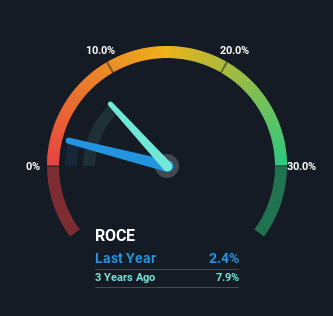- Malaysia
- /
- Water Utilities
- /
- KLSE:RANHILL
Here's What's Concerning About Ranhill Utilities Berhad's (KLSE:RANHILL) Returns On Capital
What underlying fundamental trends can indicate that a company might be in decline? More often than not, we'll see a declining return on capital employed (ROCE) and a declining amount of capital employed. Basically the company is earning less on its investments and it is also reducing its total assets. So after glancing at the trends within Ranhill Utilities Berhad (KLSE:RANHILL), we weren't too hopeful.
Return On Capital Employed (ROCE): What is it?
For those who don't know, ROCE is a measure of a company's yearly pre-tax profit (its return), relative to the capital employed in the business. The formula for this calculation on Ranhill Utilities Berhad is:
Return on Capital Employed = Earnings Before Interest and Tax (EBIT) ÷ (Total Assets - Current Liabilities)
0.024 = RM55m ÷ (RM3.1b - RM855m) (Based on the trailing twelve months to March 2022).
Therefore, Ranhill Utilities Berhad has an ROCE of 2.4%. In absolute terms, that's a low return and it also under-performs the Water Utilities industry average of 7.6%.
See our latest analysis for Ranhill Utilities Berhad

In the above chart we have measured Ranhill Utilities Berhad's prior ROCE against its prior performance, but the future is arguably more important. If you'd like, you can check out the forecasts from the analysts covering Ranhill Utilities Berhad here for free.
What Can We Tell From Ranhill Utilities Berhad's ROCE Trend?
In terms of Ranhill Utilities Berhad's historical ROCE movements, the trend doesn't inspire confidence. About five years ago, returns on capital were 7.5%, however they're now substantially lower than that as we saw above. And on the capital employed front, the business is utilizing roughly the same amount of capital as it was back then. Companies that exhibit these attributes tend to not be shrinking, but they can be mature and facing pressure on their margins from competition. So because these trends aren't typically conducive to creating a multi-bagger, we wouldn't hold our breath on Ranhill Utilities Berhad becoming one if things continue as they have.
In Conclusion...
All in all, the lower returns from the same amount of capital employed aren't exactly signs of a compounding machine. Investors haven't taken kindly to these developments, since the stock has declined 25% from where it was five years ago. With underlying trends that aren't great in these areas, we'd consider looking elsewhere.
One more thing to note, we've identified 2 warning signs with Ranhill Utilities Berhad and understanding these should be part of your investment process.
While Ranhill Utilities Berhad may not currently earn the highest returns, we've compiled a list of companies that currently earn more than 25% return on equity. Check out this free list here.
New: AI Stock Screener & Alerts
Our new AI Stock Screener scans the market every day to uncover opportunities.
• Dividend Powerhouses (3%+ Yield)
• Undervalued Small Caps with Insider Buying
• High growth Tech and AI Companies
Or build your own from over 50 metrics.
Have feedback on this article? Concerned about the content? Get in touch with us directly. Alternatively, email editorial-team (at) simplywallst.com.
This article by Simply Wall St is general in nature. We provide commentary based on historical data and analyst forecasts only using an unbiased methodology and our articles are not intended to be financial advice. It does not constitute a recommendation to buy or sell any stock, and does not take account of your objectives, or your financial situation. We aim to bring you long-term focused analysis driven by fundamental data. Note that our analysis may not factor in the latest price-sensitive company announcements or qualitative material. Simply Wall St has no position in any stocks mentioned.
About KLSE:RANHILL
Proven track record with moderate growth potential.
Market Insights
Community Narratives



